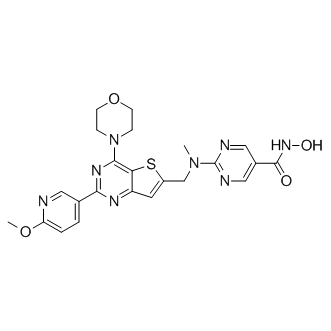| 1.Inquiries will be replied within 24 hours |
| 2.We could supply various packages as you required |
| 3.To protect the profit of our agents, price will not show on website, please send inquiries to get the price. |
| 4.Fast delivery, goods arrive your office within 3 to 5 days |
| 5.Please click "Inquiry" or "Email" below to get the price |
|
|
|
|
white powder |
|
|
C23H24N8O4S |
|
|
|
|
508.55 |
|
in stock |
|
|
1339928-25-4 |
|
99.5% |
Introduction
CUDC-907 potently inhibits class I PI3Ks as well as classes I and II HDAC enzymes with IC50 of 1.7/5.0/1.8/2.8 nM and 19/54/39 nM for HDAC1/2/3/10 and PI3Kα/β/δ, respectively. IC50 & Target: IC50: 1.7/5.0/1.8/2.8 nM (HDAC1/2/3/10), 19/54/39 nM (PI3Kα/β/δ)[1] In Vitro: CUDC-907 is a potent pan-inhibitor of HDAC classes I and II enzymes and observed that its potency against class I HDACs is similar to that of panobinostat and greater than that of vorinostat. CUDC-907 is also a potent inhibitor of class I PI3K kinases with an IC50 of 19, 54, and 39 nM for PI3Kα, PI3Kβ, and PI3Kδ, respectively. CUDC-907 markedly induces p21 protein in H460, a non-small cell lung cancer (NSCLC) cell line. CUDC-907 causes the reduction of both p-STAT3 (Y-705) and p-SRC in RPMI-8226 multiple myeloma cells and reduces both phosphorylated and total protein levels of MET and EGFR as well as HER2 and HER3 in H1975 NSCLC cells and BT-474 breast cancer cells, respectively. CUDC-907 induces caspase-3 and -7 activation in HCT-116 colon cancer cells in a dose-dependent manner. CUDC-907 potently inhibits the growth of cancer cells derived from both hematologic and solid tumors. CUDC-907 potently inhibits the proliferation of cells expressing either mutant or wild-type PI3K[1]. In Vivo: Oral administration of CUDC-907 inhibits growth of the Daudi cancer cell xenografts in a dose-dependent manner. Tumor stasis is observed at 100 mg/kg in this model without obvious toxicity. Importantly, in the same model, CUDC-907 achieves better efficacy than GDC-0941, Vorinostat, or a combination of these 2 compounds given at their maximal tolerated doses (MTD). Furthermore, CUDC-907 causes tumor regression or stasis after intravenous (50 mg/kg) or oral administration (100 mg/kg) in a xenograft tumor model of SU-DHL4 diffuse large B-cell lymphoma (DLBCL) and causes tumor stasis in KRAS-mutant A549 NSCLC cell xenografts[1].







